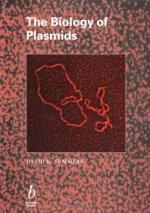|
This section contains 1,150 words (approx. 4 pages at 300 words per page) |

|
Plasmids are naturally occurring, stable genetic elements found in bacteria, fungi, and even in the mitochondria of some plants. They may be composed of DNA or RNA, double-stranded or single-stranded, linear or circular.
 The transfer gene (tra) makes a protein that binds to the origin of replication site (ori). The protein nicks the DNA, relaxing it and allowing it to be transferred to another cell.
The transfer gene (tra) makes a protein that binds to the origin of replication site (ori). The protein nicks the DNA, relaxing it and allowing it to be transferred to another cell.
Types of Plasmids
Plasmids are not usually required by their host cell for its survival. Instead, they carry genes that confer a selective advantage on their host, such as resistance to heavy metals or resistance to naturally made antibiotics carried by other organisms. Alternatively, they may produce antibiotics (toxins) that help the host to compete for food or space. For instance, antibiotic resistance genes produced...
|
This section contains 1,150 words (approx. 4 pages at 300 words per page) |

|


